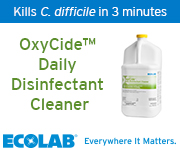
By J. Hudson Garrett Jr., PhD, and Fiona Nemetz, AHE’s EXPLORE magazineThere are many elements that go into emergency response plans, and here we’ve outlined some of the main considerations of a plan as it relates to infections prevention and control and environmental services (EVS). It is EVS’ responsibility to ensure that it is able to provide a safe place for patients to be treated and heal—regardless of the conditions outside of the organization’s walls.
|
By Bob Kehoe, Health Facilities ManagementI had some interesting conversations recently with four environmental services (EVS) directors centered on how they and their teams are using technology to optimize cleaning and disinfection performance to improve safety and boost efficiency. The interviews were part of my research for our annual Trends in Health Care report, which was released in December.
|
By Rock Jensen, Health Facilities ManagementStaffing is by far the largest expense the environmental services (EVS) department incurs, typically accounting for 75–80 percent of total department spending. Given these numbers, it’s clear that staffing has the ability to make or break the financial backbone of the entire departmental budget. No other EVS departmental successes will offset failures associated with ineffective staffing.
|


Joint Commission Resources (JCR)/Infection Control TodayJoint Commission Resources today released the January 2015 issue of the Joint Commission Journal on Quality and Patient Safety. The issue includes two articles and an accompanying editorial on hand hygiene compliance, which reduces rates of healthcare-associated infections in hospitals but has proven difficult to improve on a sustained basis.
|
Infection Control TodayThe Association for the Advancement of Medical Instrumentation (AAMI) is reporting that a top official with the U.S. Food and Drug Administration (FDA) has promised that his agency will waste no time to promote the widespread adoption of unique device identifiers (UDIs) in the U.S. healthcare system.
|
By Steven Ross Johnson, Modern HealthcareHospital intensive-care units carry a higher risk of mortality among elderly who develop an infection during their stay, according to a new study. Infection control efforts resulted in better health outcomes and reduced healthcare costs, the study also reports.
|
By Heather Punke, Becker’s Hospital ReviewWith infectious diseases like MERS and Ebola arriving in the U.S., and CMS enacting major fines on hospitals with high levels of infections, 2014 has been a year of unprecedented changes including an increased focus on infection control in the nation's hospitals and around the globe. This article includes a breakdown of five major infection control occurrences that affected U.S. hospitals this past year.
|
By Darlene A. Cunha, Hospital ImpactIn May, I talked about the attributes of great leaders. The subject drew a lot of attention over the past year, as healthcare continues to evolve in this ever-changing climate of reimbursement and accountability. Recently, Mitch Robbins wrote a blog for The HealthCare Initiative on leadership. The article was a great reminder that "... Leadership is a daily task, not just a title. Great leaders make mistakes. The difference between great leaders and others is that great leaders see these mistakes as learning opportunities."
|
By Herminia Ibarra, Harvard Business ReviewAuthenticity has become the gold standard for leadership. But as INSEAD professor Herminia Ibarra argues, a simplistic understanding of what authenticity means can limit leaders’ growth and impact. All too often, we tend to latch on to authenticity as an excuse for sticking with what’s comfortable. But few jobs allow us to do that for long. In this article, Ibarra explains how leaders can develop an "adaptively authentic" style by experimenting with many different leadership approaches. It’s OK to change tactics from one day to the next, she says. That’s not being fake; it’s how we figure out what’s right for the challenges and circumstances we face.
|
By Tamara Rosin, Becker’s Hospital ReviewFour health system and hospital CEOs from around the country shared their New Year's resolutions, anticipated challenges, goals for 2015 and essential leadership qualities with Becker's Hospital Review.
|
By Darlene A. Cunha, Hospital ImpactPerformance reviews create angst and fear. We all have to give them, and almost everyone who's evaluated hates it. More often than not, it is a pretentious, bogus practice that produces nothing any thinking executive would call a plus. Don't get me wrong, reviewing performance is good, but it should happen every day, not once a year.
|
By Rebecca Knight, Harvard Business ReviewYou hear a lot of advice about how to reduce stress at work. But most of it is about what to do over the long term—take up yoga, eat a healthy diet, keep a journal, or get more sleep. But what do you do when you’re overcome with stress in the moment—at your desk, say, or in a meeting? Perhaps you’ve heard bad news from a client or were assigned yet another project. How can you regain control?
|
The deadline for all awards is June 26, 4:30 p.m. PSTAHE’s awards and recognition program acknowledges and elevates those who have demonstrated the highest level of effort and leadership in the field of healthcare environmental services. Award recipients are those who work towards advocating and educating themselves on best practices and standards, developing leaders within the healthcare environment, and recognizing the profession in the healthcare community. Nominate someone you believe is doing an outstanding job in environmental services by nominating them today! Or, nominate yourself—your work shouldn’t go unnoticed. It would be an honor and a privilege for AHE to acknowledge and celebrate with you.
|
AHE, along with the American Society for Healthcare Risk Management teamed up to build awareness around healthcare environmental factors, including patient area surfaces, and their potential to contribute to HAI and disease transmission. Both organizations wanted to evaluate whether following an evidence-based, peer-reviewed cleaning protocol, would affect contamination levels and the incidence of pathogens that cause HAIs. The result of the project is the AHE and ASHRM Toolkit for Environmental Services and Risk Management Professionals. This toolkit showcases the informative, timely 60-minute pre-recorded on-demand webinar, "Evidence-Based Environmental Hygiene Measures to Mitigate Risk for Healthcare Associated Infections and Improve Outcomes." Register now. It’s free for AHE members.
|
Product Spotlights
|
| |
|
